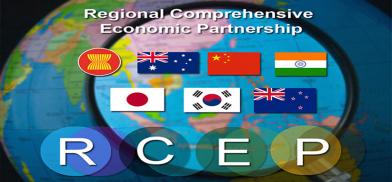RCEP and India: Read the fine print before joining
India for the time being has chosen to call for an adjournment on the multidimensional chessboard of multilateral trade/strategic agreements which can be seen as a wise move, writes Kumardeep Banerjee for South Asia Monitor

The world has seen a major economic negotiating block getting ‘next to a done deal’ in the form of RCEP, or Regional Comprehensive Economic Partnership. It is a free trade agreement between 10 ASEAN countries and China, Japan, South Korea, Australia, and New Zealand. This pact when ratified will come to represent 30 percent of the world GDP, impacting almost half of the world population and, most significantly, a multilateral trade agreement where China is a leading party.
RCEP has been at the negotiating table since late 2012 before it went stagnant in recent years as India resisted opening its industrial and agricultural sectors to increased international competition. Subsequently, given the rise of an ‘abrasively ambitious and technology-aided’ China, India had also pressed for keeping data of individual country’s citizens localized, unless the participating country granted its outbound transfer.
Mixed response to India not joining
India formally withdrew from RCEP in 2019 due to domestic demands, however despite November 15, 2020 agreement on the trade deal, India, still has an option of joining RCEP. A post-pandemic world economy gasping to revive, a new regime in America come January with a strong possibility of rejoining multilateral platforms for trade and strategic cooperation and the vision of a new India are some of the paradigms, to be kept in mind, before passing any judgment on what works best in India’s favor at this juncture.
India not joining RCEP has been received with mixed responses domestically with those opposing government’s stance stating that an isolated India in the South East Asia neighborhood, and India’s sensitivity to China imports may be more out of geopolitics than economic realizations.
To quote a study which found from 2007-08 to 2015-16, India’s imports of Chinese semi-finished goods, heavy machinery, has had a positive impact on Indian industries creating jobs, and increasing competitiveness. Those, who support the government’s moves of withdrawal, have equally strong positions on how importing these goods from China lead to job losses for unskilled in India. In the post-pandemic Indian economy, a huge chunk of jobs has to be created for this unskilled category.
The broad tenets of the RCEP agreement aim to achieve zero tariffs on 90 percent plus, traded goods between partnering countries in a decade and half .The economic impact may be dulled by the knowledge that most of these trading partners already have bilateral free trade agreements in place. However, the geopolitical impact, given a heavy Chinese presence and an ambition to create a counter block to the US-led CPTPP (Comprehensive and Progressive Trans-Pacific Partnership) can’t be overlooked.
E-commerce
It is often said that China has a huge knack for reverse mastering/engineering the skill sets developed in any successful economy and therefore, without any significant costs of indigenous development, it can scale up and produce similar goods and services at half the rates offered by original creators. The wordings of RCEP in terms of borrowed texts from CPTPP, chapters and approach seems like a similar exercise. It is here that key emerging tech policy topics like e-commerce, data localization, as envisaged in the RCEP agreement has to be studied carefully before India makes any overtures towards the block.
Electronic commerce, an evolving area of friction on bilateral and multilateral platforms, has found a chapter in the RCEP agreement document. This chapter borrows heavily from CPTPP however on execution; it has bleaker chances as the clauses (at least in their wordings) are less enforceable, ambiguous, and too tight jacketed. The dispute resolution mechanism in case of conflict must be referred to the RCEP joint committee if all other channels of negotiations fail. The contentious issues of source code disclosures requirements, data flows across trading partners, and location of data centers and computing facilities have been left for future consultations and agreements.
India and the rest of the large world economies including Europe would be watching this space closely to get cues, before trying to make any overtures. The global policy space is currently staring at tons of ideas being floated to control the flow of data beyond the sovereign’s boundaries, thereby acknowledging and equating data as a physical commodity to be traded as a chip on high tables of multilateral agreements. It would take tons of space to argue and potentially arrive at a middle path agreement between different approaches to data regulation globally, except suffice it to say, 2020 has been the beginning of national data colonization policies.
Data localisation
Staying on with data regulations the text for cross-border data flows and location of computation facilities in the RCEP document leaves ample room for subjective and therefore aggressive interpretations. Put simply the RCEP text on these topics leaves the regulatory door ajar for each country to force hard localization rules for data without being subject to scrutiny at the multilateral platform. This clause may seem to be played to the galleries domestically for each trading partner but has its own set of repercussions on global cooperation and the possibility of a weak future agreement.
There are other chapters related to cybersecurity, copyright violations, privacy, financial services, and customs duties on electronic transmissions all of which are in parts or whole being negotiated around the globe across available multilateral platforms.
India for the time being has chosen to call for an adjournment on the multidimensional chessboard of multilateral trade/strategic agreements which can be seen as a wise move.
It is always better to sleep over the problem and come back with a fresh perspective before going for Sicilian defense or the Queen’s gambit.
(The writer is a specialist in technology and trade issues. The views expressed are personal)









Post a Comment